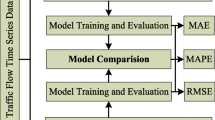Abstract
As the construction and management of subway transit system becomes increasingly mature, analyzing the passenger flow information of the normal transportation network and accurately predicting the passenger flow in a short time have become the core of subway transit system operation and management. However, it is difficult for traditional intelligent prediction algorithms to meet the high accuracy and fast response capabilities required for predicting passenger flow in a short time in unexpected situations. In order to improve the prediction performance, this paper proposes a time series prediction model based on deep recurrent neural network (DRNN). Using DRNN’s unique memory function to capture the dynamic information of the time series, we can better learn the “trend” between data at different moments, so that we can more accurately predict the output at the next moment. The comparison among the case studies based on the measured data of subway passenger flow with time series characteristics, the traditional support vector machine and the neural network method, shows that DRNN prediction has the smallest overall deviation, small deviation fluctuation and good robustness.






Similar content being viewed by others
References
Arem BV, Kirby HR, Vlist MJMVD et al (1997) Recent advances and applications in the field of short-term traffic forecasting. Int J Forecast 13(1):1–12
F Beaufays, H Sak, A Senior (2014) Long Short-Term Memory Recurrent Neural Network Architectures for Large Scale Acoustic Modeling. Interspeech, no. September 338–342
Chai Y, Huang D, Zhao L (2016) A short-term traffic flow prediction method based on wavelet analysis and neural network. Control and decision conference. IEEE 7030-1034.
Dia H (2001) An object-oriented neural network approach to short-term traffic forecasting. Eur J Oper Res 131(2):253–261
Dong Shengwei (2013) Study on short-term passenger flow prediction of rail transit based on improved BP neural network. Beijing Jiaotong University
Du Y, Wang W, Wang L. (2015) Hierarchical recurrent neural network for skeleton based action recognition [J]. Journal of intelligent perception and computing research center (CVPR):1110-1118
Enjian Y, Wenhua Z, Yongsheng Z (2018) Prediction of real-time inbound and outbound passenger flow of the new stations on urban rail transit lines in the initial stage of opening. Chin Railw Sci 02:119–127
Gensuo M, Liang L, Yang R (2015) Application of Grey variation particle swarm algorithm in prediction of bus passenger flow. Comput Eng Sci 37(1):104–110
Gooijer JGD, Hyndman RJ (2005) 25 years of time series forecasting. Monash Econ Bus Stat Work Pap 22(3):443–473
A Graves, A Mohamed, G Hinton (2013) Speech recognition with deep recurrent neural networks. 2013 IEEE Int. Conf. Acoust. Speech Signal Process (6): 6645–6649
K Gregor, A Graves, WG Com (2015) DRAW : A Recurrent Neural Network For Image Generation. Proceeding of the 32nd International Conference on Machine Learning, JMLR: W&CP 37
Guo et al (2019) Short-term abnormal passenger flow prediction based on the fusion of SVR and LSTM. IEEE Access 7:42946–42955
Han et al (2019) Short-Term Prediction of Bus Passenger Flow Based on a Hybrid Optimized LSTM Network. ISPRS Int J Geo Inf 8(9):366
Jie L, Yuming H, Hui Z, Xuejin G, Pu W (2014) A Combined Model for Predicting Short-term Passenger Flow in Urban Transportation Hubs. Trans Info Safety 32(02):41–44+49
U Lowell, J Donahue, UC Berkeley, M Rohrbach, UC Berkeley, and R Mooney (2015) Translating Videos to Natural Language Using Deep Recurrent Neural Networks. Human Language Technologies: The 2015 Annual Conference of the North American Chapter of the ACL 1494–1504
Ma S, Wuniriqiqige, Xiaoping L (2016) A review of big data and deep learning. Trans Intel Syst 11(6):728–742
R Pascanu, C Gulcehre, K Cho, Y Bengio (2013) How to construct deep recurrent Neur Networks 1–13
Smith BL, Williams BM, Oswald RK (2002) Comparison of parametric and nonparametric models for traffic flow forecasting. Transp Res C 10(4):303–321
Wang H, Yan L (2016) Predictingof metro passenger flow by combined Grey support vector machines. J Dalian Jiaotong Univ 37(2):6–9
Xiaoxue Y, Zheng Y, Lin J (2016) Passenger flow prediction of urban rail transit based on improved WNN. Comput Eng Appl 52(11):227–232
Zhu et al (2019) Prediction of passenger flow in urban rail transit based on big data analysis and deep learning. IEEE Access 7:142272–142279
Author information
Authors and Affiliations
Corresponding author
Additional information
Publisher’s note
Springer Nature remains neutral with regard to jurisdictional claims in published maps and institutional affiliations.
Foundation Project: project supported by the National Natural Science Foundation of China (71771151)
Rights and permissions
About this article
Cite this article
Liu, D., Wu, Z. & Sun, S. Study on Subway passenger flow prediction based on deep recurrent neural network. Multimed Tools Appl 81, 18979–18992 (2022). https://doi.org/10.1007/s11042-020-09088-x
Received:
Revised:
Accepted:
Published:
Issue Date:
DOI: https://doi.org/10.1007/s11042-020-09088-x




